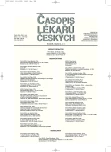New options of influenza vaccination
Authors:
R. Chlíbek
Authors‘ workplace:
Univerzita obrany Brno a Fakulta vojenského zdravotnictví Hradec Králové
doc. MUDr. Roman Chlíbek, Ph. D.
Published in:
Čas. Lék. čes. 2010; 149: 111-114
Category:
Topic
Overview
One of the ways to increase a low rate of vaccination against the flu in the Czech population is using new vaccination methods, e.g. the intradermal flu vaccine application method. This method uses a high skin immune potential, where a great amount of dendritic cells, macrophages, lymphocytes as well as abundant capillary and lymphatic supply can be found. A progressive microneedle application system allows the accurate application right into the dermis and a dosage consistency without any necessity of much experience and training in intradermal administration. Comparable results of immunogenity with lower antigen content and less vaccine amount are reached with intramuscular application in adults up to 59. Using the same antigen amount as in intramuscular application in people older than 60, significantly better results are reached. A new intradermal vaccine IDflu is registered in Europe for people from the age of 18 and it is considered to be a new alternative way to raise popularity of flu vaccination in lay and professional public. The microneedle intradermal application system brings an easier way of vaccination for doctors with application of less amount of vaccine and there is no need to remove air from the syringe and no need of aspiration. The vaccine will be introduced in the Czech market before the flu season 2010/2011. Key words: vaccination, influenza, intradermal application.
Sources
1. Mantoux C. L`intradermo-reaction a la tuberkuline et son interpretation clinique. Presse Medicale 1910; 18: 10–13.
2. Belshe RB, Newman FK, Canon J, et al. Serum antibody response after intradermal vaccination against influenza. N Engl J Med 2004; 351: 2286–2294.
3. La Montagne JR, Fauci AS. Intradermal influenza vaccination-can less be more? N Engl J Med 2004; 351: 2230–2232.
4. Azad N, Rojanasakul Y. Vaccine delivery-current trends and future. Curr Drug Deliv 2006; 3: 137–146.
5. Strauss K, Van Zindert K, Frid A, Costiglioda V. Pandemic influenza preparedness: the critical role of the syringe. Vaccine 2006; 24: 4874–4882.
6. Ward BJ. The potential Benefits of Intradermal Vaccination. Presentation on the 13th International Congress on Infectious Diseases, Kuala Lumpur, Malaysia, 21 June 2008.
7. Laurent A, Mistretta F, Bottigioli D, et al. Echographic measurement of skin thickness in adults by high frequency ultrasound to assess the appropriate microneedle lenght for intradermal delivery of vaccines. Vaccine 2007; 25: 6423-6430.
8. Laurent PE, Bonnet S, Alchas P, et al. Evaluation of the clinical performance of a new intradermal vaccine administration technique and associated delivery system. Vaccine 2007; 25: 8833–8842.
9. Leroux-Roels I, Vets E, Freese R, et al. Seasonal influenza vaccine delivered by intradermal microinjection: A randomised controlled safety and immunogenicity trial in adults. Vaccine 2008; 26: 6614–6619.
10. Holland D, Booy R, De Looze F, et al. Intradermal influenza vaccine administered using a new microinjection system produces superior immunogenicity in elderly adults: a randomized controlled trial. J Infect Dis 2008; 198(5): 650–658.
11. Sanofi Pasteur. Internal data. Clinical trials.gov NCT00258934.
Labels
Addictology Allergology and clinical immunology Angiology Audiology Clinical biochemistry Dermatology & STDs Paediatric gastroenterology Paediatric surgery Paediatric cardiology Paediatric neurology Paediatric ENT Paediatric psychiatry Paediatric rheumatology Diabetology Pharmacy Vascular surgery Pain management Dental HygienistArticle was published in
Journal of Czech Physicians

Most read in this issue
- Adrenocortical insufficiency and diabetes mellitus type 1
- New options of influenza vaccination
- Urologic complications of HIV infection
- Impact of mechanical circulatory support on renal function in a patient with end stage heart failure
